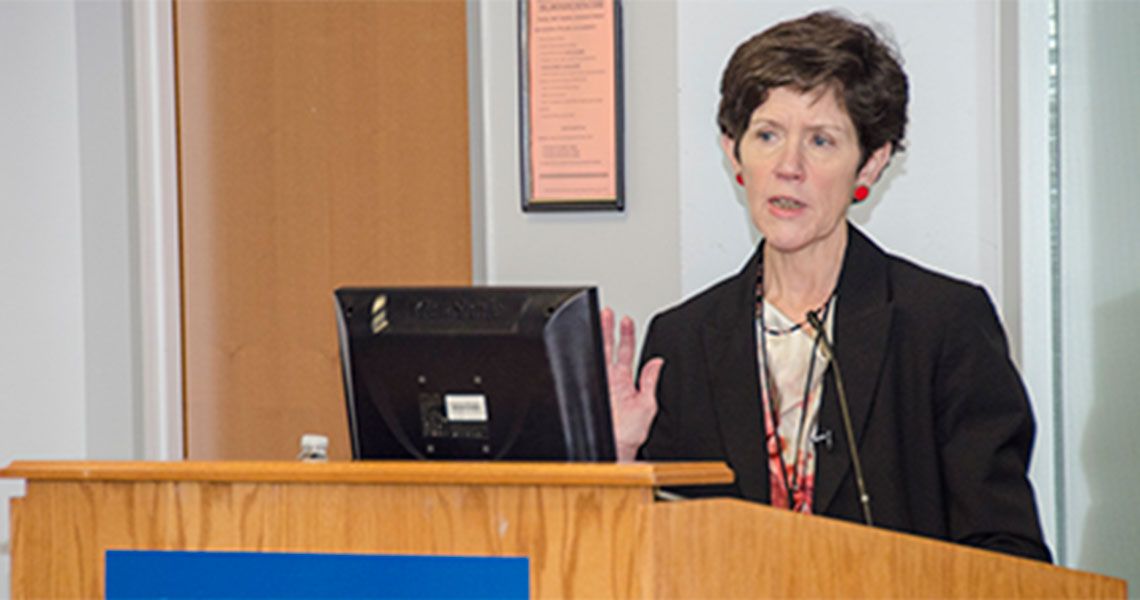“It can be exhausting and unpredictable, but this is an incredibly exciting period of time in health care,” said Carolyn M. Clancy, M.D., assistant deputy undersecretary for quality, safety, and value at the Veterans Health Administration and associate clinical professor of medicine at GW’s School of Medicine and Health Sciences (SMHS). Clancy, who directed the Agency for Healthcare Research and Quality (AHRQ) at the U.S. Department of Health and Human Services for nearly a decade, shared her perspective on the future of health care quality during the inaugural SMHS Annual Health Care Quality Lecture, Oct. 17.
During the lecture, which was streamed live via webcast, Clancy noted that quality of health care in the United States varies dramatically. “Our challenge is providing the right care for the right patient at the right time, every time. It’s that ‘every time,’ the reliability, that we are still struggling with a bit. It’s very expensive.”
As Director of the AHRC, Clancy oversaw the development of an annual report on health care quality and health care disparities for submission to Congress. “The good news is that every year for the past decade we’ve seen statistically significant improvements in quality,” Clancy said. “But statistically significant isn’t the same thing as clinically important.” The annual rate of quality improvement is slow — between 2 and 2.5 percent — and health care disparities remain a persistent challenge.
The fundamental problem with our current health care system, according to Clancy, is that “the way we pay for care rewards doing more care.” She is encouraged, however, by the Affordable Care Act’s provisions for improving quality and introducing a national strategy for health care. The three broad aims— better care, healthy people/health communities, and affordable care — relate to the need for health care organizations to establish organic connections with community members who provide support for patients. “It’s easy for those of us in health care to say ‘quit smoking,’ ‘lose weight,’ ‘watch your blood sugar.’ It’s pretty straightforward; not rocket science,” said Clancy. “But actually doing it is harder than rocket science.”
Clancy outlined the six priorities that have been identified by AHRQ’s National Quality Strategy: making care safer by reducing harm caused by delivery of care, ensuring that each person and family is engaged as partners in their care, promoting effective communication and coordination of care, promoting the most effective prevention and treatment practices for the leading causes of mortality, working with communities to promote wide use of best practices to enable health living, and making quality care more affordable by developing and spreading new health care delivery methods. “There’s teamwork written all over this list,” said Clancy. “Historically that’s not how we’ve trained health professionals. It’s a big change, but it’s very exciting.”
Clancy highlighted the important role of health IT in creating a system that provides high-quality, safe, affordable, and reliable care. Until recently, she said, the commercial technology available to health care providers was built for a system that rewarded volume. With the new focus on quality, “the whole enterprise is having to transform,” Clancy said. “IT is going to allow us to change the metaphor from hunting [for information] to farming. We’ll be growing new evidence as a by-product and learning from what we do. With the right kind of information system, we could learn systematically. That’s the promise of health IT.”
Clancy also stressed the importance of engaging patients in their own care in order to improve health outcomes. This can be done, she said, by asking patients what their goals are and to repeat what they’ve heard. “We’re talking so far over people’s heads when they’re going home, and they’ve got 100 other things on their minds. You really need to be asking people to play it back all the time,” Clancy said. “Starbucks knows this. You tell them what you want, they tell you back.”
In closing, Clancy noted that progress has already been made in the realm of quality, and there is much more to come. And, most crucially, “there is a very important role for health professionals to play in helping to build this enterprise and make it better.”



